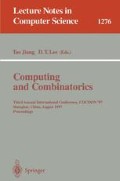Abstract
The paper presents an algorithm for the problem of deciding whether or not a language L, given in terms of the state transition graph of the reduced finite state automaton whose language is L, can be generated by a splicing system with a finite initial set of strings using a given enzyme set X. The algorithm is based on the properties of cycles of the state transition graph that should be satisfied if the language can be spliced with a finite initial set of strings.
Preview
Unable to display preview. Download preview PDF.
References
K. Culik II and T. Harju, Splicing semigroups of dominos and DNA, Discrete Applied Mathematics 31 (1991), pp. 261–277.
R.W. Gatterdam, Algorithms for Splicing Systems, SIAM J. Computing 21 (1992), pp. 507–520.
M. Harrison, Introduction to Formal Language Theory, Addison Wesley, (1978).
T. Head, Formal Language Theory and DNA: An Analysis of the Generative Capacity of Specific Recombinant Behaviors, Bulletin of Mathematical Biology 49 (1987), pp. 737–759.
J. Hopcroft and J. Ullman, Introduction to Automata Theory, Languages and Computation, Addison Wesley, (1979).
S. Kim, R. McNaughton and R. McCloskey, A Polynomial Time Algorithm for the Local Testability Problem of Deterministic Finite Automata, IEEE Trans. Computers 40 (1991), pp. 1087–1093.
S. Kim, Computational Modeling for Genetic Splicing Systems, (to appear in SIAM J. Computing)
S. Kim, Identifying Genetically Spliced Languages, Proc. of ICEC'97, pp. 231–235.
Author information
Authors and Affiliations
Editor information
Rights and permissions
Copyright information
© 1997 Springer-Verlag Berlin Heidelberg
About this paper
Cite this paper
Kim, S.M. (1997). An algorithm for identifying spliced languages. In: Jiang, T., Lee, D.T. (eds) Computing and Combinatorics. COCOON 1997. Lecture Notes in Computer Science, vol 1276. Springer, Berlin, Heidelberg. https://doi.org/10.1007/BFb0045107
Download citation
DOI: https://doi.org/10.1007/BFb0045107
Published:
Publisher Name: Springer, Berlin, Heidelberg
Print ISBN: 978-3-540-63357-0
Online ISBN: 978-3-540-69522-6
eBook Packages: Springer Book Archive

